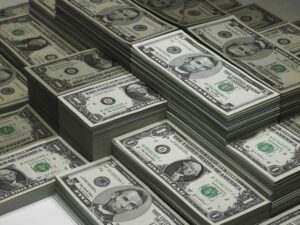
Kiwi Rallies on Improved Economic Sentiment; U.S. Inflation Report Anticipated

The New Zealand dollar (NZD) posted strong gains on Thursday following an optimistic business outlook survey, while the U.S. dollar (USD) struggled to maintain its momentum ahead of a crucial U.S. inflation report set for Friday.
The upcoming release of the core Personal Consumption Expenditures (PCE) price index, the Federal Reserve’s preferred inflation measure, is the highlight of a relatively quiet week for major market-moving data. Despite this, the NZD stood out, reaching an eight-month high of $0.6295 after a survey revealed that New Zealand’s business confidence in August soared to its highest level in a decade. As of the latest session, the NZD was up 0.73% at $0.6291.
According to Michael Gordon, Senior Economist at Westpac New Zealand, “Business confidence has lifted sharply following the Reserve Bank of New Zealand’s (RBNZ) policy shift.” Earlier this month, the RBNZ executed its first interest rate cut in over four years, signaling the potential for additional cuts.
Gordon added, “We don’t believe that a single OCR (official cash rate) cut alone could have this substantial impact on the economic outlook. Rather, it reflects how pessimistic businesses had become earlier in the year.”
In broader currency markets, the USD was under pressure, struggling to find support after a 0.48% rise in the previous session, partly due to month-end demand. The euro (EUR) edged back toward its 13-month high, trading at $1.1135, while the British pound (GBP) rose 0.14% to $1.3209, close to its peak since March 2022. The Australian dollar (AUD) also neared an eight-month high, gaining 0.27% to $0.6803.
Carol Kong, a currency strategist at Commonwealth Bank of Australia, noted, “While the PCE inflation data is this week’s most critical release for the U.S., it is unlikely to significantly shift market expectations for Federal Open Market Committee (FOMC) policy unless there is a substantial surprise.”
Market participants have already priced in a 25-basis-point rate cut from the Federal Reserve next month, with a 34.5% probability of a more aggressive 50-basis-point reduction, as indicated by the CME FedWatch tool. The outlook for U.S. interest rates has been further shaped by recent remarks from Fed Chair Jerome Powell at the Jackson Hole symposium, where he suggested that “the time has come” to reduce rates, echoing sentiments from other Fed policymakers.
The prospect of lower U.S. rates has weighed heavily on the USD, which had been buoyed over the past two years by the Fed’s aggressive tightening cycle. The greenback has declined approximately 2.9% this month, heading for its steepest monthly drop in nine months. The dollar index was last down 0.07% at 100.94, after hitting a 13-month low of 100.51 earlier in the week.
Meanwhile, the Japanese yen (JPY) held steady at 144.67 per dollar and is on track for a 3.7% gain this month. Unlike the Fed, the Bank of Japan (BOJ) has signaled a willingness to raise interest rates if inflation remains on target, providing some support for the yen, which has been under pressure due to significant interest rate differentials. Lombard Odier strategists suggest that “with the Fed nearing rate cuts and the BOJ normalizing policy, the USD/JPY should move closer to its fair value of around 135.”
For the latest updates on forex trends and insights, stay tuned to our website.
Never miss any important news. Subscribe to our newsletter.
Related News


USD/INR Slows Down Amid Mixed Indian PMI Data.


USD/INR Rises as Markets Anticipate Fed Rate Decision.


Gold Price Nears Record High Amid Strong Safe-Haven Demand.



USD/INR Gains Momentum Amid Trade Tariff Uncertainty.



Never miss any important news. Subscribe to our newsletter.
Editor's Pick


USD/INR Slows Down Amid Mixed Indian PMI Data.


USD/INR Rises as Markets Anticipate Fed Rate Decision.



